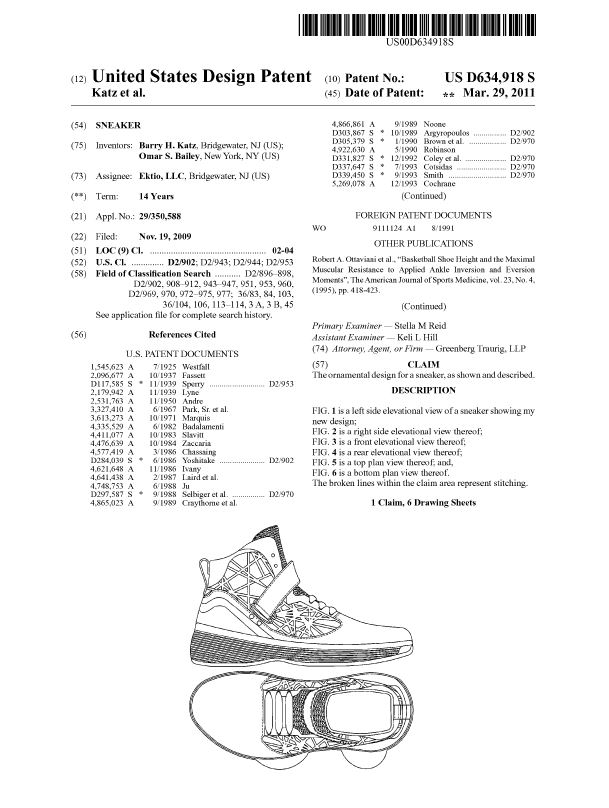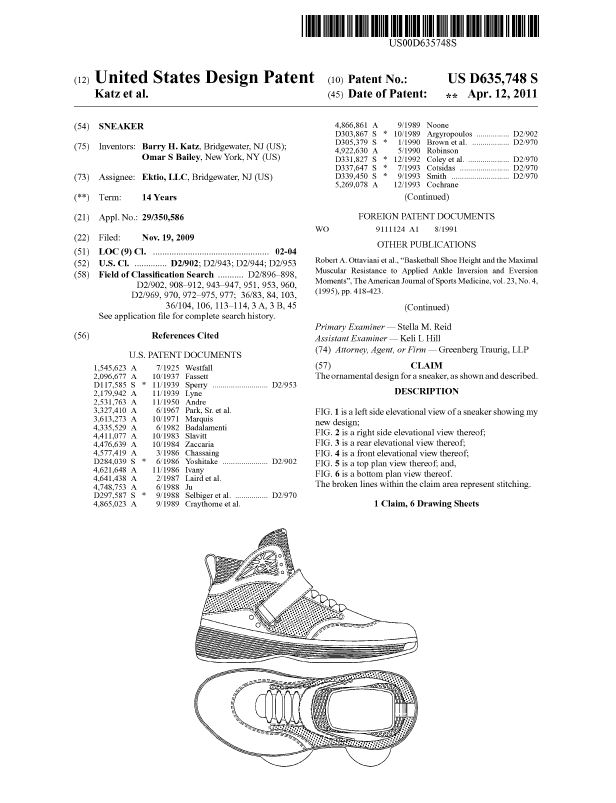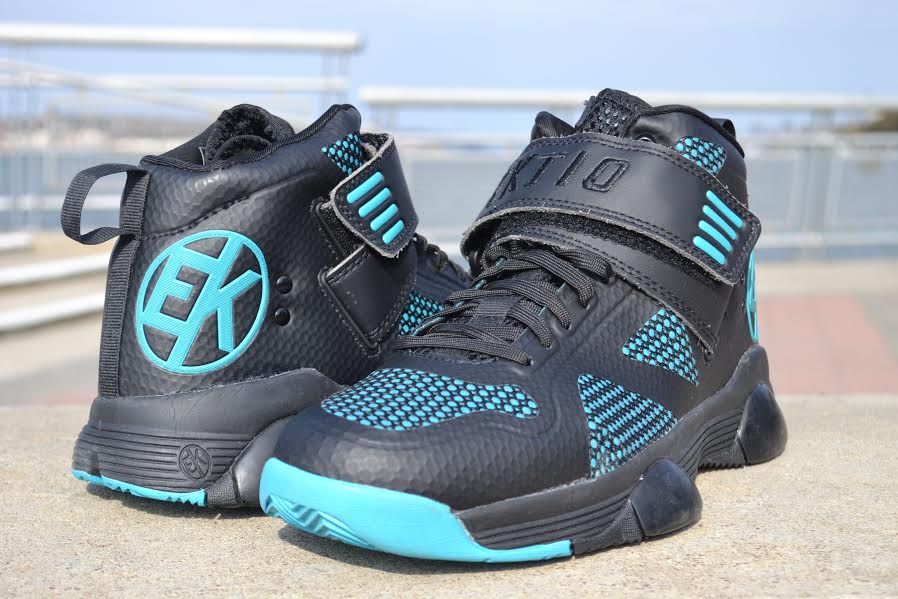Companies have been making claims about performance and protection from their athletic shoes for decades. Few however, have been as straight forward as Ektio. Founded by Dr. Barry Katz and promoted by former NBA stars Rick Barry and hometown favorite John Starks, Ektio aims to make ankle sprains in basketball a thing of the past with patented ankle support technology that promises to protect basketball players from ankle sprains. Reviews have been positive for the small brand and offerings are expanding. We recently caught up with Barry to talk about all things Ektio and ankle sprains.
DeFY: Hi Barry, thanks for sitting down with DeFY. I understand you’re in the medical field, what’s your background?
Barry: Yes, I’ve been a physician radiologist for a long time. I received my medical degree in 1982. I also played a lot of sports while I was growing up so I’ve been involved in sports as well so I have a dual background in sports and medicine.
DeFY: Do you or did you ever collect sneakers?
Barry: No, I never collected sneakers.
DeFY: What made you want to dive into the footwear industry?
Barry: I wanted to help prevent ankle injuries.
DeFY: I think it’s a great product if it does what it claims (which according to reviews, seems it does). A friend and contributor to the site needed 3 pins in his ankle after breaking it. Would this product help someone like him that has suffered a serious ankle injury?
Barry: Not only would they be good for an individual like that but also for people that have sprained their ankle either recently or in the past or people that have never sprained their ankle who want to stay healthy. It’s the number one injury in basketball so it’s really a simple equation as far as we’re concerned. If you care about ankle safety and support; wear Ektio. If ankle support is not a concern to you, you should wear another shoe. There’s nothing on the market that gives you any significant ankle support.
We calculated and figured out how many shoes we’ve sold and figure the average player plays 6 hours a week, roughly 3 two hour sessions a week (and we know some players play a lot more than that and some less) so we took 6 as an average.
We also know from published studies that there are 5.5 ankle sprains per 1000 hours of play.
So if you calculate the expected number of ankle sprains in our shoe over the past 3 ½ years by taking the number of ankle sprains that actually happened divided by the expected number of sprains, it shows that we’ve reduced ankle sprains among our users by 99.9%. This is better than even we expected to do. We have a bunch of doctors that invented the shoe, who figured it out, and understand how ankle sprains happen and how to prevent it. A lot of really smart minds went into the development of this technology.
DeFY: Ok, the positives have been discussed both in this interview as well as others. I figured we should tackle some of the questions/comments made online by the skeptics and nay-sayers. One individual is concerned that if their ankle is restricted then their knee might be injured, what do you say to that?
Barry: There’s a lot of myths out there, everybody thinks they’re an expert on things they’re not an expert on, and when it comes to the ankles, everyone has an answer. If everyone was such an expert why are there 9 million ankle sprains a year and 100 ankle sprains every year in the NBA and the best athletes are wearing high top or low top shoes, braces and tape?
It’s because people don’t understand the ankle injury; they don’t understand it. I’ve talked to people about all the myths regarding ankle injuries, and there’s almost as many myths as there are about concussions. I’ll tell you why it’s wrong and prove it to you. The mechanism of an ankle injury is when you jump and land on someone’s foot, your shoe rolls over and causes the stress to go on the outside of the ankle ligaments. That’s not the way knee injuries occur. Knee injuries occur because the foot plants in the ground or turf and there is a twisting of the knee joint, which is a totally different mechanism of injury. Secondly, all we are doing is converting a potential ankle injury into a square landing where people don’t hurt themselves. When we figured this out at the beginning we didn’t anticipate that there would be any increase in knee injuries, and we talked to many orthopedic surgeons at a number of places. I asked if they thought that there would be an increase in knee injuries, and none of them thought there would be. As it turns out there hasn’t been, and that makes sense to anyone who really understands the ankle injury and the knee injury. We predicted there wouldn’t be any increases. I heard of one knee injury in our shoes but knee injuries can occur wearing any basketball shoe at any time so it had nothing to do with our shoe. It’s just that people hurt their knee playing basketball doing other things. So it’s not an issue.
DeFY: Someone suggested that a player could just wear a low top shoe that’s not as stabilizing as your shoe and that most of those guys get their ankles taped up. Wouldn’t that achieve the same injury minimizing result?
Barry: That’s been proven to be wrong a thousand times over. If you look in the NBA and college the players are all taped and they still suffer from ankle sprains. Any trainer or anyone that knows anything about tape knows that the tape only works 15 minutes. In that time you’re only done with warmups, and it gets loose. People sprain their ankles all the time with tape and sprain their ankle all the time with braces as well. So, if it was such a good solution there wouldn’t be 9 million ankle sprains a year in the United States. It should work but it doesn’t work. So that’s what people were doing, but not looking at the results that show it doesn’t work. Our solution works, we’ve essentially eliminated ankle sprains, and it’s the only thing on the market that does that.
DeFY: I read in another interview with Rick Barry that you have no current NBA endorsers for the shoe because they want to get paid. Rick suggested that the athlete shouldn’t be worried about money, they should just be worried about protecting their career. I also read that some of the major brands are in some ways blocking or preventing you guys from locking down an athlete.
Barry: Well, the players are most concerned with endorsement dollars, and so there’s never been an athletic shoe that helps prevent injury.
So, they’re doing what they’ve always done, and that’s going to the highest bidder, and you know that I can’t blame them for that.
DeFY: Yea.
Barry: They’re about making money while they can. On the other issue I don’t think anyone is blocking us, I just think that they have more resources than we do to bring in NBA players. With the market the way it is, it’s a challenge for a young company in the athletic footwear business to break in.
DeFY: Did you ever consider endorsing a street baller? Remember the late 90’s early 2000’s where everyone was about Rucker Park and street basketball and you had a company like And1 that really backed that world? People kind of drifted away from that, and everything is about the million dollar NBA athlete and less about the above average street baller, is that something you would ever consider?
Barry: And1 had their brand based on street ball and being cool and all that type of stuff. There’s certainly a fashion component to a lot of athletic footwear, people wearing the shoe because of fashion. We’re not going after that type of customer.
If that kind of customer wants to wear our shoe, that’s great, but we’re really going after players that are concerned about ankle safety. Focusing on street ball players is not necessarily the kind of marketing we would do. I’d be happy if they wear our shoe, but that’s not our primary customer, you know that’s a little different market.
DeFY: So are you targeting the NBA or just the average guy that’s going to play on weekends? The average guy might not be conditioned like a professional athlete, and therefore should be more prone to getting hurt right?
Barry: That’s another myth. You said that a professional athlete is less likely to hurt their ankle than a guy that’s a weekend warrior right?
DeFY: Yea
Barry: That’s completely totally not true. The reason is because there’s, and this is one of those myths, if you’re really well conditioned and have really strong legs you can really build up muscles and protect against an ankle injury. Well, the fact is there are no muscles in the ankle. There’s just ligaments, tendons and bones. There’s 100 ankle sprains in the NBA this year, the best athletes in the world, and they are no better protected from ankle injuries than the average player. Just look at guys like Kobe and Lebron, they sprain their ankles constantly. Steph Curry sprains his ankle constantly, Devon Harris, Derek Nowitzki, Tim Duncan, and Tony Parker all these guys sprain their ankles so many times you can’t even count. So, that’s interesting because people think that if you’re an NBA guy that you’re in better shape. However, if they jump and land on someone’s foot, they’re going to sprain their ankle just like a 40 year old guy that’s 30 pounds overweight. It’s no different. It’s about the number of minutes played, so starters tend to sprain their ankles more than bench players. So we’re targeting people that want to protect themselves and have a safe basketball experience. People that have sprained their ankle a few months ago, people that have had chronic sprains and people that have never sprained it. Whether it’s a young kid that’s 14 to 19 playing on a school team, or people that are playing in college or men’s leagues.
DeFY: Let’s talk design. One of the comments was that they didn’t care how well a shoe performed, they wouldn’t wear them unless they were flashy. They think that Ektios need to have more “pop”. Are there any plans to incorporate exotic materials? I know it’s all about tech and really protecting ankles but are there any plans to maybe collaborate with a boutique down the line and do something special?
Barry: Well, our Breakaway shoe is pretty contemporary, it’s not crazy colors but there’s certainly modern materials in that shoe. It’s a fused upper, TPU mesh and we’re coming out with a new model at the end of 2014 which we think pops more. It’s a flashier shoe but our goal is not to be the flashiest shoe, or be the most cutting edge on materials. Our goal is to be a good looking shoe that performs well, that’s comfortable, and it protects the athlete. So we try to come up with designs we think people will like, but other companies have to come up with crazy designs because that’s what they’re about. It’s important to us but it’s not as important as the safety element and performance.
DeFY: Would you ever license the technology to another company?
Barry: To the right company, right partner, sure.
DeFY: Are there any plans to branch out into other sports besides basketball?
Barry: Absolutely, there’s a lot of other activities where ankle sprains are a common injury and we plan on getting into these as our company matures. We see our technology in sports like Volleyball, Tennis, Running, Hiking, in construction boots and military shoes. All these different sports and activities have a high instance of ankle sprains, and we can take our technology and put it into any shoe like that.
DeFY: Where can individuals go to try the shoes out in person? Are there any stores where people can go and try them on before ordering them?
Barry: Right now we’re primarily online Eastbay, Amazon, our own site.
We have some stores in Canada and Japan, and other places around the world, but right now we are not in any of the major stores. They have to try them on, and if the shoe doesn’t fit there’s free exchanges so they can get the right size.
DeFY: It seems like the American consumer constantly needs validation from another country on what’s hot, and I know Ektio has been introduced to Japan. How are the shoes doing in that market?
Barry: The big retailers there are definitely on board with us, and I believe the Japanese are very open to new ideas and technologies. They seem to be excited about our new concept and idea.
DeFY: Is there anything else you want people to know about Ektio shoes, anything you may have to say to those that think that the company won’t stick around?
Barry: Well I want to say that people that think the shoes will not help you have never worn the product. Everyone that has put the shoe on sees the value in the shoes, and probably wants to own a pair. They see it doesn’t restrict your mobility like braces and tape, both of which don’t prevent ankle sprains. Our shoe prevents the ankle sprains but it doesn’t restrict movement, you get both. People think that you can’t come up with new innovation except what’s out there today. We are here to show that there is very significant technology that can really add to current footwear. Most importantly, it can solve the biggest health problem for basketball players, which is sprained ankles. It’s the number one injury in just about any sport you can think of. Never before has there been a solution to ankle sprains that has worked. We’re the first company that can prevent it. Ektio works and we’ve proven it. We have a long track record and it’s only going to get more exposure over the years as people take more interest in staying healthy.
For more info on Ektio and to pick up a pair for your rotation visit Ektio.com and follow them on Facebook and Twitter. Also, you can learn more from the video below.





